Navigation
Student Work
Writing and Editing in Print and Online: Overview
WEPO students coded their reflections as part of a basic HTML webpage,
incorporating as many GIFs into their text as they deemed appropriate. As
with many of the previous projects in the class, students took quite different
approaches with the assignment. For example, one student’s project [opens new window]
focused on what she called the “whys of writing,” revising
 how she defined and thought about writing:
how she defined and thought about writing:
This student opened her reflection with a large GIF gradually covering over with the question “why?” This particular GIF served to establish the theme of the reflection to follow, as the question “why” seems to guide her review of her class experiences. A second student focused on the projects specifically, [opens new window] and her GIFs almost exclusively highlighted the tools she encountered in the class. She grounded this focus in her claim:
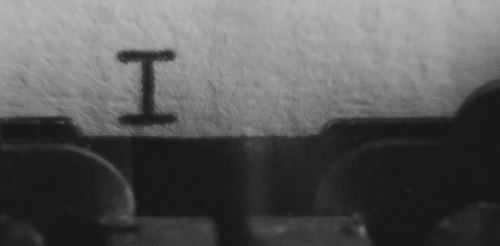
In this way, this students’ choice of GIFs were a reflection of impact, a way to underscore the highlights of the class that left a memorable impression. Taking a different approach, another student described her personal experiences throughout the semester, [opens new window] from day one until the final day, narrating her highs and lows exclusively with Harry Potter GIFs. Using a series of GIFs with the Draco Malfoy character, she writes:
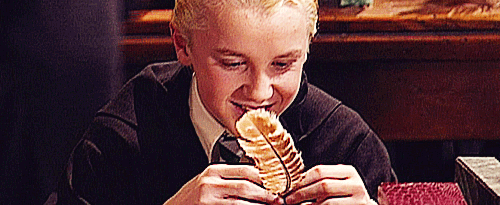
Despite the fact that students took different approaches, all students used the GIFs in sync with the text, employing them to highlight themes, demonstrate memorable moments, and showcase dramatized emotional responses. These elements were present in the written text itself, but looking at how the GIFs and texts work together shows that students are using these modes in sophisticated ways.
History of Illustrated Texts: Overview
The History of Illustrated Texts assignment did not require true
multimodal illustration: students were not specifically prompted to use sound or
video and  most focused
on mastering the basic coding required to display still images. For the majority
of students, this was their first time attempting to create a webpage without
the use of templates. In the final result, two of the nine groups chose to
illustrate their excerpts entirely with GIFs, one group chose a mix of GIFs and
still images, one used still images with a moving marquee, and the rest selected
static images. While GIFs were not required, student groups that chose to use
GIFs were more likely to discuss extended engagement with readings of specific
textual passages in their responses. All students were asked to comment on how
they selected images relevant to their website; students selecting static images
often mention selecting images that “fit the Knight’s Tale
theme very well,” or choosing images that were highly iconographic. A
student from a group that chose to illustrate the Wife of Bath’s Tale
with still images described their selection process in terms of finding
images that fit the plot at key moments:
most focused
on mastering the basic coding required to display still images. For the majority
of students, this was their first time attempting to create a webpage without
the use of templates. In the final result, two of the nine groups chose to
illustrate their excerpts entirely with GIFs, one group chose a mix of GIFs and
still images, one used still images with a moving marquee, and the rest selected
static images. While GIFs were not required, student groups that chose to use
GIFs were more likely to discuss extended engagement with readings of specific
textual passages in their responses. All students were asked to comment on how
they selected images relevant to their website; students selecting static images
often mention selecting images that “fit the Knight’s Tale
theme very well,” or choosing images that were highly iconographic. A
student from a group that chose to illustrate the Wife of Bath’s Tale
with still images described their selection process in terms of finding
images that fit the plot at key moments:

In a HoIT project titled “The Wife of Bath's Tale: Illustrated in The Graphics Interchange Format,” [opens new window] a group of four students foregrounded the use of GIFs as an integral part of their presentation of the Tale. Emphasizing the importance of GIFs in their title, their rationale, and in the layout of the webpage itself, these students drew from sources as diverse as the movie Toy Story, the television show Suits, and born-digital clips to create a “descriptive yet funny modern day narration of the Wife of Bath.” They identified the tale as humorous, despite its depiction of rape; as one student described it:

In “The Wife of Bath's Tale: Illustrated in The Graphics Interchange Format,” each GIF was chosen to express a specific emotion or narrative situation and placed near a relevant line. The number of GIFs involved in this particular project was ambitious, as was the length of the excerpt over all. The students decided to break up their lengthy selection and divided subsections among the group members, who were each assigned to read their subsection and submit relevant GIFs. As sometimes happens, this ambition was driven by one particular group member, the student who took on the coding, and she chose to supplement the GIFs provided by at least one of her fellow group mates. In her write up, she explained:
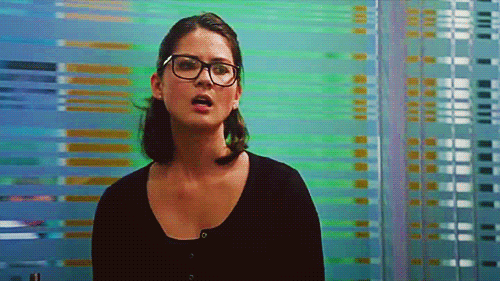
Conversely, the student she complains about phrased the disjuncture in work as a choice on her part:
There was some diversity in the arrangement, with GIFs in some sections appearing directly below the relevant line, so that the text was read first, and in others directly above the relevant line, so the GIF was read first. The choice of whether to place the GIF before or after the relevant lines seems to have been influenced more by the number of GIFs provided for a given section rather than by a deliberate choice on the part of the coder.
Emotion
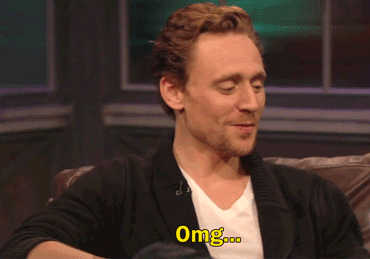
Rather than depicting a literal image of the action being described, as students
selecting still images often chose to do, the students in the
“Graphics Interchange” group attempted convey an emotion,
mood, or attitude relevant to the textual moment. This is emphasized at points
in the text by selectively bolded words—all with emotional
connotations—that serve as introductions to the images that follow.
For example, to illustrate the concept that women were most happy
“When we are flattered and when we are
pleased,” the students chose a clip from an interview of Tom
Hiddleston. Clearly, the gesture—a blush and a hand going to his heart
in response to flattery—was more important than personal
characteristics, even gender. The disregard for gender in this context seems
particularly telling, as the passage was a part of a series of answers to the
question of “what/ It is that women most desire” and
conflict between men and women is central to the narrative. Indeed, the emphasis
on emotion and gesture over characteristics such as age and gender mean that a
single narrative character is often represented by diverse GIFs. The “Old Woman”
of the tale, for example, appears both as a contestant
from Toddlers and Tiaras and Stewie Griffin from Family
Guy—neither of whom are, notably, old women. Conversely, the same
character from a given source might represent different referents in different GIFs.
Meryl Streep appears twice in her role as Amanda Priestly from The Devil
Wears Prada, both times associated with actions in King
Arthur’s Court. She appears, however, to represent opposite sides in
the narrative conflict: in the first GIF, her dismissive hand gesture matches
the moment when King Arthur gives the knight to Guinevere for justice. Thus, this
GIF represents either Arthur’s handing over of responsibility or
Guinevere’s direction of the court. In the second GIF, Streep’s confident removal of
sunglasses stands in for the injunction from the Old Woman to the knight
“to be glad and have no fear.” In using the GIFs, the
students clearly expected tone, gesture, and emotion to have influence on their
readers’ understanding of the tale and were not concerned that using
the
same character for different referents might confuse their reader.
different referents in different GIFs.
Meryl Streep appears twice in her role as Amanda Priestly from The Devil
Wears Prada, both times associated with actions in King
Arthur’s Court. She appears, however, to represent opposite sides in
the narrative conflict: in the first GIF, her dismissive hand gesture matches
the moment when King Arthur gives the knight to Guinevere for justice. Thus, this
GIF represents either Arthur’s handing over of responsibility or
Guinevere’s direction of the court. In the second GIF, Streep’s confident removal of
sunglasses stands in for the injunction from the Old Woman to the knight
“to be glad and have no fear.” In using the GIFs, the
students clearly expected tone, gesture, and emotion to have influence on their
readers’ understanding of the tale and were not concerned that using
the
same character for different referents might confuse their reader.

Much like the HoIT projects, WEPO students employed GIFs almost universally to demonstrate an emotional response to various classroom experiences. The GIFs coded alongside these narratives were often highly dramatized expressions of emotions, coloring a previous uncomfortable situation with humor, or demonstrating a memorable moment of success during the semester. One student, comparing her experiences between using a word processor and using a typewriter or pencil, writes:
At this point, this student includes a GIF of Jonah Hill screaming and shaking his head. These kinds of extreme, highly performative expressions of emotions seem to be the norm throughout all our students’ projects. In this way, the GIFs serve primarily an affective role, heightening the pathos of the written text by offering a brief physical performance of an emotional experience.
Avatars
Fleckenstein (2005), in her development of the concept
“cyberethos,” argues that “the soul of the user
[is tied to] the soul of the avatar” (p. 331). However, although the
avatar serves as “a graphic-discursive representation” of
identity (p. 330), Fleckenstein notes, “We cannot locate identity or
good character within the avatar because the avatar exists only by means of a
user's graphical-discursive transactions within a particular
environment” (p. 334). Nor, can we disentangle the “embodied
user” from the discourse of the digital avatar. Significantly, despite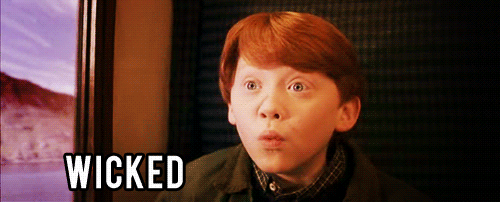 the different pedagogical and writing contexts, displays of emotions via GIFs
for both the WEPO and HoIT students trumped other identifiers such as age,
gender, or race. However, perhaps indicative of the reflection genre, only in
the reflection projects were the GIFs representative of the author him/herself.
Josh’s projects displayed a shifting relationship
between the changing avatars of the assorted GIFs and the student herself.
the different pedagogical and writing contexts, displays of emotions via GIFs
for both the WEPO and HoIT students trumped other identifiers such as age,
gender, or race. However, perhaps indicative of the reflection genre, only in
the reflection projects were the GIFs representative of the author him/herself.
Josh’s projects displayed a shifting relationship
between the changing avatars of the assorted GIFs and the student herself.

One student described her process of engaging with HTML
for the first time by employing a series of GIFs featuring the Ron Weasely
character. The student using Weasley as an avatar could have identified with a Harry
Potter character of her own gender and general age, but instead chose a
character whose gestures, reactions, and visual emotions best fit her
purpose in composing the text. In her text, this student first describes her confusion about and then her
interest in HTML, followed by a description of an attempt with this new skill that translated into “disaster” and
“panic.” Ultimately, after some help and a bit of practice,
she explains that “everything will be okay in the end.”
Throughout her description of this experience, we
see the Ron Weasley character, an avatar for the student, dramatically
playing out this student’s emotions. The use of GIFs as avatars
alongside text is significant because, in addition to establishing
the ecological relationship between users and avatars, these projects
give us a glimpse into how a user’s attachment to an avatar can shift
frequently within a single text. Further, such a practice might be indicative of
“constructive reflection,” which, as Yancey (1998) claims, involves
the development of “a cumulative, multi-selves, multi-voiced
identity” that occurs between multiple texts (p. 14).
that translated into “disaster” and
“panic.” Ultimately, after some help and a bit of practice,
she explains that “everything will be okay in the end.”
Throughout her description of this experience, we
see the Ron Weasley character, an avatar for the student, dramatically
playing out this student’s emotions. The use of GIFs as avatars
alongside text is significant because, in addition to establishing
the ecological relationship between users and avatars, these projects
give us a glimpse into how a user’s attachment to an avatar can shift
frequently within a single text. Further, such a practice might be indicative of
“constructive reflection,” which, as Yancey (1998) claims, involves
the development of “a cumulative, multi-selves, multi-voiced
identity” that occurs between multiple texts (p. 14).
Narrative Arcs
Quite regularly in the reflections coded in the WEPO class, students  describe
what Josh calls “encounter narratives”—that is,
students regularly described either fear, nervousness, or tentativeness on one
hand, or excitement and curiosity on the other. Often these narratives involved
the uncertainty and discomfort of entering a new class at the beginning of the
semester and students regularly used the GIFs as a way to dramatize their often
challenging encounters with some of the technologies we studied in the class.
Ultimately, these narratives resolved themselves, concluding either in a victory
over adversity or a moment of knowledge or awareness. One student wrote:
describe
what Josh calls “encounter narratives”—that is,
students regularly described either fear, nervousness, or tentativeness on one
hand, or excitement and curiosity on the other. Often these narratives involved
the uncertainty and discomfort of entering a new class at the beginning of the
semester and students regularly used the GIFs as a way to dramatize their often
challenging encounters with some of the technologies we studied in the class.
Ultimately, these narratives resolved themselves, concluding either in a victory
over adversity or a moment of knowledge or awareness. One student wrote:
Alongside this text, the student employed two GIFs: one of an owl perched in the snow, head bowed sadly; the second, a scene from Ron Burgundy: Anchorman in which all the characters are jumping for joy. Significantly, the narrative arc implied here is an emotional arc, a story of personal growth and changing feelings in relation to composition.
On the other hand, in the “Graphics Interchange” Wife of
Bath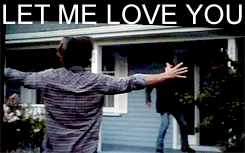 in Meaghan’s class, very few of the GIFs are employed
solely to signal significant narrative moments, either actions in the plot,
changes in setting, or the introduction of a specific character. Rather, the
typical GIF provides some sort of emotional commentary on that plot point,
commentary that attempts to push the reader towards a specific interpretation of
the text. For example, the rape which begins the narrative is represented by a
clip from the television show Supernatural, captioned “LET ME
LOVE YOU.” The slapstick nature of this depiction fits with the
stated goal to “bring comic relief to the tale.” Likewise,
selecting clips from Mean Girls to represent the knight’s reentry
into Camelot and Toy Story 3 for the moment when “He married
her that morning privately/Then all that day he hid just like an
owl,” provide commentary on the knight’s awkward social
plight and immature reaction to the outcome,
in Meaghan’s class, very few of the GIFs are employed
solely to signal significant narrative moments, either actions in the plot,
changes in setting, or the introduction of a specific character. Rather, the
typical GIF provides some sort of emotional commentary on that plot point,
commentary that attempts to push the reader towards a specific interpretation of
the text. For example, the rape which begins the narrative is represented by a
clip from the television show Supernatural, captioned “LET ME
LOVE YOU.” The slapstick nature of this depiction fits with the
stated goal to “bring comic relief to the tale.” Likewise,
selecting clips from Mean Girls to represent the knight’s reentry
into Camelot and Toy Story 3 for the moment when “He married
her that morning privately/Then all that day he hid just like an
owl,” provide commentary on the knight’s awkward social
plight and immature reaction to the outcome, respectively.
respectively.
The exceptions to this use of GIFs as interpretive commentary tend to occur on
the periphery of the tale. The Wife of Bath’s Tale is set in the sphere of Arthurian legend, a
time (according to the text) marked by the presence of elves and fairies. In the
introduction, the text notes: “But now such elves no one is
seeing” and the students chose to represent this tangential piece of
information (elves appear nowhere else in the Tale) with a clip of Will Ferrell
from the movie Elf screaming “Noooooooooooo”.
Similarly, the piece ends with a GIF representing the Wife of Bath’s
Prayer, the action of prayer (or perhaps the textual unit of the prayer itself)
represented by the actress Rose Byrne crossing herself. The only clip which clearly focuses on setting
is perhaps the most emotionally-neutral clip in the series, showing a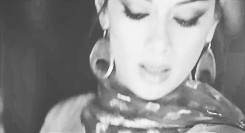 number of red-cloaked riders entering the gates of a castle, presumably Camelot.
Only two GIFs represent specific characters in a way that visually confirms
characteristics described in the text: King Arthur appears as the Burger King,
and “Some ladies dancing, twenty-four or more” encountered
by the Knight on his quest are represented with a clip from a Pussycat Dolls
music video. Without a greater sample set, it is difficult to tell whether the
peripheral nature of these basic representations of plot, setting, and character
are a common trend in the remediation of literature or a stylistic
choice.
number of red-cloaked riders entering the gates of a castle, presumably Camelot.
Only two GIFs represent specific characters in a way that visually confirms
characteristics described in the text: King Arthur appears as the Burger King,
and “Some ladies dancing, twenty-four or more” encountered
by the Knight on his quest are represented with a clip from a Pussycat Dolls
music video. Without a greater sample set, it is difficult to tell whether the
peripheral nature of these basic representations of plot, setting, and character
are a common trend in the remediation of literature or a stylistic
choice.